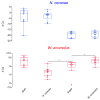Effects of a Resident Yeast from the Honeybee Gut on Immunity, Microbiota, and Nosema Disease
- PMID: 31540209
- PMCID: PMC6780889
- DOI: 10.3390/insects10090296
Effects of a Resident Yeast from the Honeybee Gut on Immunity, Microbiota, and Nosema Disease
Abstract
The western honeybee (Apis mellifera) has a core bacterial microbiota that is well described and important for health. Honeybees also host a yeast community that is poorly understood with respect to host nutrition and immunity, and also the symbiotic bacterial microbiota. In this work, we present two studies focusing on the consequences of dysbiosis when honeybees were control-fed a yeast that was isolated from a honeybee midgut, Wickerhamomyces anomalus. Yeast augmentation for bees with developed microbiota appeared immunomodulatory (lowered immunity and hormone-related gene expression) and affected the microbial community, while yeast augmentation for newly emerged bees without an established bacterial background did not lead to decreased immunity- and hormone-related gene expression. In newly emerged bees that had a naturally occurring baseline level of W. anomalus, we observed that the addition of N. ceranae led to a decrease in yeast levels. Overall, we show that yeasts can affect the microbiome, immunity, and physiology.
Keywords: health; honeybee; microbes; microbiota; yeasts.
Conflict of interest statement
The authors declare no conflict of interest.
Figures


References
Grants and funding
LinkOut - more resources
Full Text Sources

